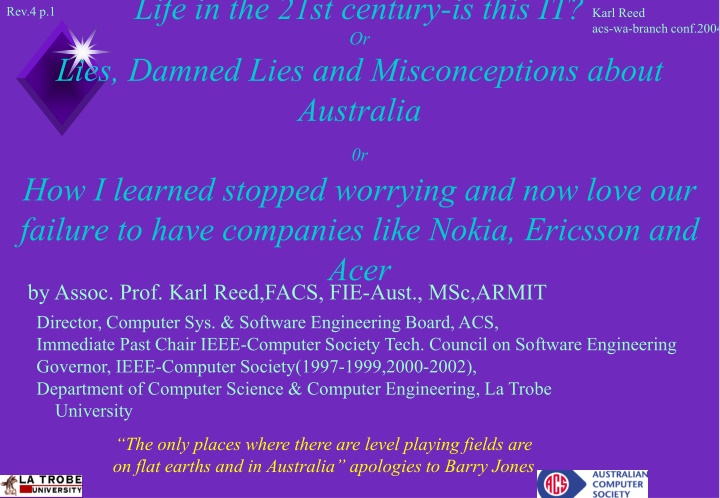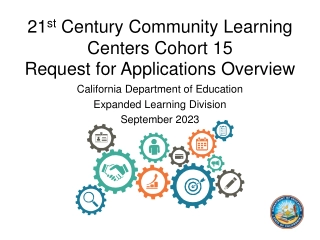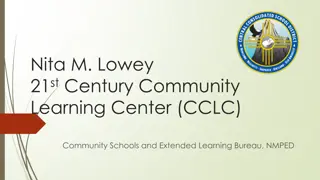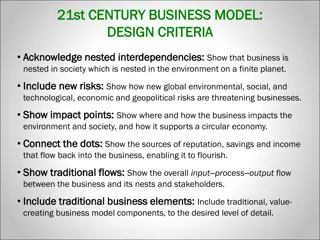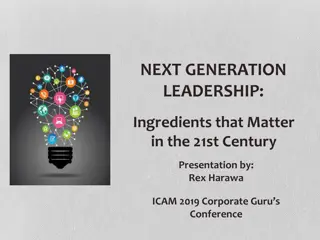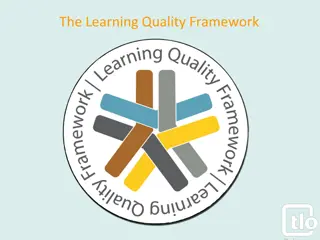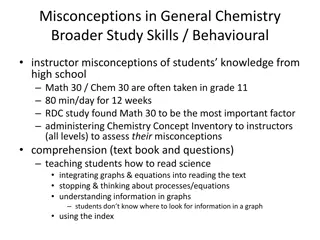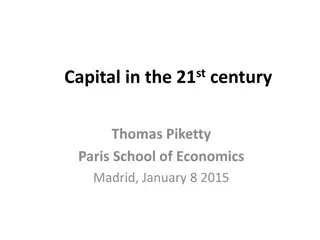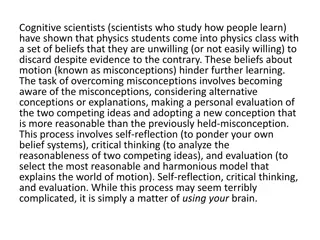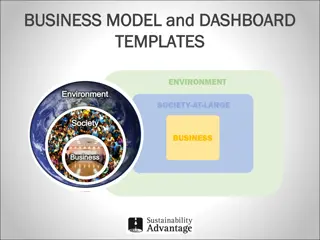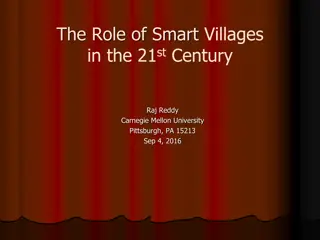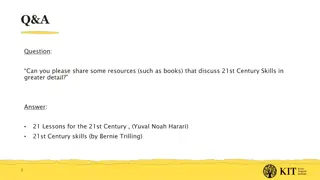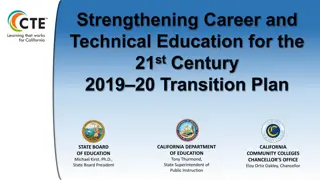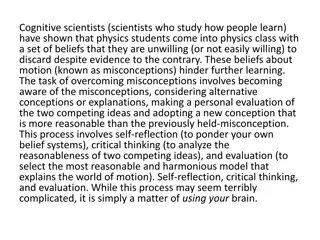Life in the 21st Century: IT, Lies, and Misconceptions about Australia
Delve into Assoc. Prof. Karl Reed's insightful take on the state of life in the 21st century, focusing on the role of IT, misconceptions about Australia, and the failures in developing companies like Nokia and Acer. Explore the impact of technology on society, economy, and workforce, reflecting on the unfulfilled promises of the past and the realities of the present day.
Download Presentation

Please find below an Image/Link to download the presentation.
The content on the website is provided AS IS for your information and personal use only. It may not be sold, licensed, or shared on other websites without obtaining consent from the author.If you encounter any issues during the download, it is possible that the publisher has removed the file from their server.
You are allowed to download the files provided on this website for personal or commercial use, subject to the condition that they are used lawfully. All files are the property of their respective owners.
The content on the website is provided AS IS for your information and personal use only. It may not be sold, licensed, or shared on other websites without obtaining consent from the author.
E N D
Presentation Transcript
Life in the 21st century-is this IT? Or Lies, Damned Lies and Misconceptions about Australia Rev.4 p.1 Karl Reed acs-wa-branch conf.2004 0r How I learned stopped worrying and now love our failure to have companies like Nokia, Ericsson and Acer by Assoc. Prof. Karl Reed,FACS, FIE-Aust., MSc,ARMIT Director, Computer Sys. & Software Engineering Board, ACS, Immediate Past Chair IEEE-Computer Society Tech. Council on Software Engineering Governor, IEEE-Computer Society(1997-1999,2000-2002), Department of Computer Science & Computer Engineering, La Trobe University The only places where there are level playing fields are on flat earths and in Australia apologies to Barry Jones
Rev.4 p.2 Karl Reed acs-wa-branch conf.2004 This Talk 1. Life in the 21st century-what we expected and what has gone wrong is IT to blame.. Some of things that we shouldn t believe about Australia? 2. The relative importance of the IT sector in the Australian economy-(why can t we export more software than wine?) 3. The failure of industry policy with respect to IT.. Some personal and ACS history 4. The industry was a regional leader in the 1980 s and early 1990 s 5. NEVER received government support of the kind provided to industries in other fields,and in other countries 6. Impact of Government Purchasing 7. Conclusion There views herein are those of the author, and do not necessarily reflect ACS policy
Rev.4 p.3 1. Life in the 21st century-what we expected and what has gone wrong is IT to blame.. Some of things that we shouldn t believe about Australia? Karl Reed acs-wa-branch conf.2004 In the 1960 s, there were predictions about life in the 21st century . The first blush of cybernetics and high- productivity technology offered . IN AUSTRALIA, THE REALITY IS DIFFERENT Av. working week from 42hrs to 44hrs in 20 years Cities degenerate as population increases We spend much of non-working time commuting, looking at email, being available 24/7-THE END OF VOLUNTEERISM!!! (effects ACS..) Unemployment is ~three times that in the mid 1960 s (~5.6% vs 1.9%), There has been continuous military conflict since mid 1950 s A 24 hour working week Cities that were beautifully planned Leisure would be more important than work An educated society would spend its time on sport and the arts Unemployment would disappear War would be non-existent Work to live not live to work We live to work ..
Rev.4 p.4 1. Life in the 21st century-what we expected and what has gone wrong is IT to blame.. Some of things that we shouldn t believe about Australia? We promote IT as a means of productivity improvement.. However, its not always the case.. The availability of email,mobiles and home/portable computers means that you are always contactable, and can work from home..all the time.. Ubiquitous deployment of desk-top systems in businesses has minuses as well as plusses-uncontrolled data collection and forms generation-enterprise documents become private data, often password protected-(what happens if an employee is hit by a bus?) Banks seem to be forcing us to use electronic banking whether we want to or not.. Telephone menu systems can drive users crazy Poor web-sites create web-rage Research by Strassman (cited by Verheof) suggests that .. that there is no relation between information management per employee and return on shareholder equity. Also there is no relation between profits and annual IT spending. DESPITE THE PROBLEMS, IT DELIVERS QUITE AMAZING FUNCTIONALITY, ABOUT 1B. PEOPLE WORLD WIDE DEPEND ON COMPUTER SYSTEMS FOR THEIR DAILY OPERATIONS THE WEB , DESPITE PROBLEMS, IS AN AMAZING SOCIAL RESOURCE Karl Reed acs-wa-branch conf.2004
Rev.4 p.5 Karl Reed acs-wa-branch conf.2004 An airline web-site.. As an example of non-optimal design..
Rev.4 p.6 Karl Reed acs-wa-branch conf.2004 Stages of SE... Immature methodologies, Fortran, Cobol, Assembler- 70 s,telephone systems Customer req dominate,ROI mandatory Cottage industry, but well intentioned Systems Analysis and Design methodologies 70 s-80 s Formal Methods, info. Hiding, architecture, strong typing, CASE,RE,SCS,formalised testing, banking networks,internet,PC-OS, Determinate, quality driven, high reliability, business model oriented Mature? Body of Knowledge but no universal success OO,CMM,Process Modelling,re-use, cots,dig.flight control systems,EFTPOS Cottage industry, reversion to the old-days Unreliable, technology history free, ROI independent-business model? s/w surprises Large-scale s/w, comsumer goods,engine management systems, ABS time to market, extreme programming, web systems, free-ware, 94-00 s
Rev.4 p.7 Karl Reed acs-wa-branch conf.2004 4. THE EXTREMA Fine-grained methodology & doc. inspecific shorter than time to design Time-To-Market Deliver novel solutions rapidly Extreme Programming Web-hacking Attractive to uninformed managers Create power for the new-wave of wunderkinder (yet again ) Safety Critical Systems Mission-critical systems Large-scale eftpos/on- line/whole of business (SAP) Fine-grained methodology specific Deliver novel/stable solutions slowly Attractive where high cost of failure Recognise established method and skill
Rev.4 p.8 PROFESSIONALISM AND PROFESSIONAL REGULATION We need to decide whether we (IT) are a profession or a hobby Another myth is that there isn t much professional regulation in Australia.. How about Victorian School Teachers Plumbers Electricians S/w testers for gaming machines Builders (Vic, and several states) Civil Engineers (Qld) Marsupial animal rescuers (Vic) Money market dealers Financial advisors Karl Reed acs-wa-branch conf.2004 Psychologists Doctors Medical Specialist Licensed Aircraft Mechanics And how many more? IT PROFESSIONALS HAVE ACCESS TO/PRODUCE SYSTEMS WHICH AFFECT OUR SECURITY AND WELL- WE NEED PROPER PROFESSIONAL STANDARDS AND REGULATION
Rev.4 p.9 Karl Reed acs-wa-branch conf.2004 Life in the 21st century-what we expected and what has gone wrong is IT to blame.. Some of things that we shouldn t believe about Australia? NO.. IT IS NOT THE CAUSE OF 21ST CENTRY ILLS.. 1. HOWEVER, THERE ARE MANY PROBLEMS THAT NEED TO BE FACED.. AND.. AUSTRALIAN SOCIETY HAS NOT REAPED THE BENIFIT FROM OUR HIGH QUALITY TRAINING AND EARLY LEAD IN SOFTWARE DEVELOPMENT WHY CAN T WE MAKE THE DESCISIONS TO PROMOTE AND SUPPORT AN AUSTRALIAN IT INDUSTRY?
Rev.4 p.10 Karl Reed acs-wa-branch conf.2004 Some of things that we shouldn t believe about Australia? Tiffen, R and Gittens, R How Australia Compares Cambridge University Press, 2004 THE REALITY IS DIFFERENT 1. Aus. Works year is 1855hrs, vs 1643hrs 2. 31.5% vs av. 39.4%, Sweden 54.2% 3. 10 cities in China > Melb.,8 in Europe 4. Only Sweden, NZ and Finland do better 5. Sweden has a high-speed rail network, area from Melb. to Bundaberg 6. So how can Sweden, Finland and Taiwan do it? the myths 1. Australian s are lazy and not productive 2. We are over taxed 3. We have very small cities..(Perth is a small city) 4. We need more University entry places 5. Our low population density is a barrier to a national high-speed rail system 6. Small population is a barrier to technology exports 7. We lack capital for investment in hi-tech 7. A$100 sB. s super, no local hitech ind. 8. So what do the wine industry, agr.super- cat people know? 9. Only US and Ireland have less 8. We can t commercialise our ideas, so we need foreigners to do it 9. To many holidays
Rev.4 p.11 THERE IS SOMETHING IN OUR COLLECTIVE PSYCHE, OUR SELF-IMAGE THAT SEEMS TO STOP US.. Karl Reed acs-wa-branch conf.2004 cf. Brazil National Campaign.. The best in Brasil is Brasilian! But we are a sophisticated people, and solve subtle and complex problems.. Our AIDS response was the best in the world.. Our road safety campaigns are bench-marks for other countries Medicare GOLD was a stroke of genius! WHY NOT OUR INDUSTRY POLICY ?
Rev.4 p.12 THE RELATIONSHIP BETWEEN UNREALISED ASPIRATIONS FOR 21ST CENTURY, PROBLEMS IN CURRENT IT AND AUSTRLIAN FUTURES IN IT .. WHAT IS THE LINK? Many of the IT problems are end-user quality issues the cost of adoption is too high.. Some of the 21st century issues are due to loss of balance between work and leisure, some due to globalization and loss of sovereignty Breaking open new IT product markets requires new paradigms for product-quality, delivery platforms Vast Bulk of businesses in any country are less than 5 people! Can t afford high- adoption cost applications Most untapped global markets have per capita GDP s <US$4k p.a. The country that addresses these issues first will develop industry dominance, and make a social contribution REQUIRES COMMITMENT TO INDUSTRY POLICY Karl Reed acs-wa-branch conf.2004
Rev.4 p.13 Karl Reed acs-wa-branch conf.2004 WHAT ARE THE LINKS? We fail to adopt radical approaches to (town-planning, industry policy,health policy,transport policy) because we believe untruths about ourselves The way out is self-knowledge . Many of our IT problems, and their social consequences, are due to product- drive designs dependence on WINTEL style systems A bold, unfettered and uninhibited Nation, self-confident and skilled could change this. The next waves of applications are:- unbiquitous,small company, web-site redevelopments, v. low cost markets Requires very high quality, low (zero) adoption impact applications- invisible in terms of your work-practices (ZAIA [REED 2003]) A fundamentally new paradigm for design and development AN INDUSTRY DEVELOPMENT STRATEGY BASED UPON THE ABOVE, WOULD PROTECT US AGAINST OUT-SOURCING HOW? SEE 1,2,3 ABOVE.. 1. 2. 3. 4.
Rev.4 p.14 2. The relative importance of the IT sector in the Australian economy-And public infrastructure(Trewin,D. ABS 2004 Year Book Australia ,Houghton,J 2003,csiro snapshot,crc website) Karl Reed acs-wa-branch conf.2004 ICT . 2. Income (ABS) is $77.5B (00-01) * 3. Government infrastructure to support.. Small Groups in Departments in each state,QLD ??? NICTA,VPAC,SEA Total ICT Services $A$39.6B 1+2*0.5 divisions of CSIRO, ~A$72Mp.a. ~372 staff NA (Private R & D A$1.7B*) 1. Australia s GDP for 01-02 A$695.7B 2. Primary (gross Value) A$39.6B 3. Government infrastructure to support.. Depart of Agr. Or P. I. In each state & commonwealth More than one State Govt. funded research centre in each state ~8 divisions of CSIRO A$389 p.a., >3000 staff (~1/A$5B.pa.) Industry R & D Levies, matched by Feds 23 CRC s Offices in each region in each state (cf.vic)acs.wa.bc.2004/vic.dpi.major.office - 4C476.html ~1500 full-time public servants 8 CRC s NA ?? NA Several Commonwealth Bureau s researching policy and economics *Software & Services A$15.6B
Rev.4 p.15 2. The relative importance of the IT sector in the Australian economy-(how does software compare with wine?) napshot,crc website) Karl Reed acs-wa-branch conf.2004 Software Industry Exports ~A$1.3B (IT Services software related) ~A$0.5B* (product related) Wine Industry Exports.. A$2.3B The relative trade balances? You guess . Software and services ~ -A$480, ALL ICT > -$A10B! *Total of product and royalties
Rev.4 p.16 2. The relative importance of the IT sector in the Australian economy-(why can t we export as much more software than wine?)(Trewin,D. ABS 2004 Year Book Australia ,Houghton,J 2003,csiro snapshot,crc website) Karl Reed acs-wa-branch conf.2004 In the mid 1980 s, the acs/sia team used to speculate on whether the wine industry would reach the billion dollar export threshold before the software industry did--- both made it, but one has a massive negative trade balance! In the mid-1980 s, the Software Industry was a world leader in terms of product concept and quality, the most powerful on the pacific rim.
Rev.4 p.17 Karl Reed acs-wa-branch conf.2004 3. The failure of industry policy with respect to IT.. Some personal and ACS history why it really mattered.. IN THE PERIOD 1985 TO 1995, AUSTRALIA HAD A UNIQUE OPPORTUNITY TO BECOME A WORLD POWER IN SOFTWARE AND SERVICES.. IT ALMOST WRECKED IT COMPLETELY..
Rev.4 p.18 Karl Reed acs-wa-branch conf.2004 A Bit of History . Software 1. The Australian Software Industry, and our large-scale computer users produced many major firsts or equalled them, in terms of major software developments -Earliest Builder style tools developed in Australia in late 1970 s -World s first on-line TAB mid 1960 s -Early large-scale on-line banking (SSBV,mid1970 s) -Early large-scale OO commercial systems (CML-smalltalk) -First AS-400 development tool (Aspect,mid 1980 s) -Large-scale student record system (Callista, ~2000) -Large-scale relational DB s produced by BHA -Two commercially viable re-engineering specialist companies 2.The industry was a regional leader in the 1980 s and early 1990 s 3. NEVER received government support of the kind provided to industries in other fields,and in other countries 4. The largest service companies were Australian owned.. Aspect, Computer Power, Ferntree, Hanson, Praxus, and more 5. The industry was backed by very high quality tertiary trained staff, and had excellent local customer bases. IT WAS POISED FOR MAJOR EXPANSION, GIVEN THE RIGHT SUPPORT
Rev.4 p.19 WHAT AN INDUSTRY NEEDS Karl Reed acs-wa-branch conf.2004 THE SCORE CARD in the late 80 s EXCELLENT GOOD BY WORLD STANDARDS Poor, risk investment capital limited by tax regimes, no understanding Almost non-existent Product and service concepts Domestic market share Investment Capital-informed investors Public sector R&D 1. 1. 2. 2. 3. 3. 4. 4. Almost non-existent compared with primary ind. Government Infrastructure - Ministers, full-scale departments, policy development mechanisms, independent sources.. ACCESS TO GOVERNMENT MARKETS! IMPORTANT BECAUSE OF THE VOLUME OF COMPUTER-BASED DEVELOPMENT UNDERTAKEN BY GOVERNMENT Good supply of trained people 5. 5. 6. Moderate.. Much s/w development inhouse, tied to h/w procurement, some companies did well 6. 7. Excellent 7.
Rev.4 p.20 Why the Government Market is Important Karl Reed acs-wa-branch conf.2004 Relatively large, stable contracts with a client who will pay.. Creates credibility with non-government prospects With appropriate policy, can, through aggregation of demand, create new product development opportunity (The SA Procurement Development Program was adopted by the Commonwealth, but, the details were wrong ) Permitting Australian companies to be prime-contractors provided profit taking and control opportunities that strengthened the industry.. Reduces risks associated with mission critical activities being undertaken by non-locals.. (Most of the big government contract failures in the 70 s were with trans-nationals..) Increases rate of growth of local companies.. Increases profit taking by Australian owned companies Reduces whole of life-cycle costs, Local companies more responsive 1. 2. 3. 4. 5. 6. 7. 8. 9.
What is needed to make it work Rev.4 p.21 Karl Reed acs-wa-branch conf.2004 Recognition by Government that this is an industry development issue, and that up-front charges may be higher.. 1. Tendering processes that don t discriminate against medium sized local companies Identification of exemplar projects, where success is guaranteed, to create confidence with Departments Software Engineering R & D institutes to strengthen the industry, and support Government in dealing with it Number of overseas assessment trips for politicians and public servants to be the same independently of location of contractor. Contract bonding systems tailored for local companies 2. 3. 4. 5. 6.
What is needed to make it work Rev.4 p.22 Karl Reed acs-wa-branch conf.2004 Recognition by Government that this is an industry development issue, and that up-front charges may be higher.. Departments need to have their budgets adjusted to recognise this, or, a separate fund can compensate them. 1. Tendering processes that don t discriminate against medium sized local companies Identification of exemplar projects, where success is guaranteed, to create confidence with Departments Stakeholders on the ground can sabotage these schemes Software Engineering R & D institutes to strengthen the industry, and support Government in dealing with it US SEI has this as part of its remit Number of overseas assessment trips for politicians and public servants to be the same independently of location of contractor. Contract bonding systems tailored for local companies 2. 3. 4. 5. 6.
Rev.4 p.23 WHAT WENT WRONG? Karl Reed acs-wa-branch conf.2004 POLICY MAKERS BOUGHT THE IT-USAGE AS BEST BENEFIT POLICY 1. related to a combination of the self-image issues raised earlier, and the failure of indigenous industry representation which left AIIA dominant, and the influence of traditional industry sectors (backed by massive Government infrastructure) The privatisations soaked up about A$30B-A$60B in investment funds Government procurement policy was changed to include liability requirements that excluded local suppliers (Osborne et. al. were wiped out very quickly..) GOVERNMENT EDP DEVELOPMENT/PROVISION WAS OUTSOURCED, AND WAS NOT RESERVED FOR LOCAL COMPANIES!!! Result large transnational service companies obtained most of the contracts, some achieved critical competitive mass from a standing start!! 2. 3. 4.
Rev.4 p.24 WHAT THE MAJOR PROBLEMS? Karl Reed acs-wa-branch conf.2004 1. GOVERNMENT EDP DEVELOPMENT/PROVISION WAS OUTSOURCED, AND WAS NOT RESERVED FOR LOCAL COMPANIES!!! Result large transnational service companies obtained most of the contracts, some achieved critical competitive mass from a standing start!! IF AWARDED TO AUSTRALIAN COMPANIES, WE WOULD HAVE HAD INTERNATIONALLY SIZED UNITS WITH TURN-OVERS PERMITTING THEM TO EASILY BECOME GLOBAL PLAYERS! INSTEAD .. IBM GSA AND EDS BECAME MAJOR PLAYERS Government contracts have helped their competitive position in other markets Opportunity for Australian companies to use Government requirements to develop new products for internal sale was lost.
Rev.4 p.25 Karl Reed acs-wa-branch conf.2004 OUTSOURCING . What Australia should do?(see the Gartner presentation in your folder..) propose the Australian Sports Development Model.. -talent-id -nature`,protect and research -invest -compete HAVE A GOAL, THE CREATION OF AUSTRALIAN TRANSNATIONALS OF THE SIZE OF ERICSSON?
Rev.4 p.26 Karl Reed acs-wa-branch conf.2004 What Should Australia Do? Protect and Nature . -Develop Australian standards that are super-sets of our competitors, mandate them and help local companies reach them, -Block Offshoring for a period of five-six years, using the reverse of the US approach to beef in the FTA.. Reduce protection gradually.. (Plenty of precedents for this .) -Ensure government outsourcing contacts go to local companies to allow then to grow -Encourage venture capital.. (~$40Binvested in old industries in the last 15 years for little new economic activity) -Establish a world-class research centre in IT Economics, and intelligence buerau.. Commonwealth Govt.Bureau of IT Industries.. As good as the Tiawanese III 2.
Rev.4 p.27 Karl Reed acs-wa-branch conf.2004 What Should Australia Do? Invest .. Largely in R&D to develop new products and development methods.. - IT-Security systems, - Dramatically raise productivity.. - product-line and reuse techniques, and component based development techniques -cross-domain isomorphisms -encourage domain specialisation - High(er) quality products.. This means product quality standards,Safety Critical Systems Techniques - Zero Adoption Impact Applications (Reed, 2003).. - Develop skills and products for the re-vamp of web-sites that will come soon.. - High-yield,high efficiency testing - reengineering of legacy systems - Establish collaborative skunk-works to develop proof of concept demos of new product ideas. 3.
Rev.4 p.28 Karl Reed acs-wa-branch conf.2004 History of Industry Associations ACS-Software Industry Committee - a National Committee of ACS Council Formed 1973 at suggestion of Dr. Bob Northcote Manager ICL Software Development Centre, in SA First Chair (as far as I know) Dr. Peter Claringbold, Chief CSIRO Computing Research-stood down due to conflict of interest.. Karl Reed, Ericsson research engineer appointed May 1974 Committee formed mid 1974, Jack Vale (replaced by Roger Allen) Computer Power, John Marquette, Lyndsay Cattermole , Max Rogalsky, Trevor Pearcey + Others October 1974 presented a constructive 130 page submission to the IAC in 1974 (Reed and Prof. C.S. Wallace made the presentation). Addressed access to markets, government purchasing, industry development, venture capital, R&D, aggregation of Govt. demand, standard, machine independent compilers,export incentives, and a National Computing Research Institute Industry Seminars organised.. Software Where, Soft Why, Soft How 1976- 1977 (Alex Warman..) First contacts between IT Industry and Government (1977, 1978)
Rev.4 p.29 Karl Reed acs-wa-branch conf.2004 History of Industry Associations ACS-Software Industry Committee - a National Committee of ACS Council ..(cont d) SIC proposes Franklin Dam finding ($500m) be diverted to Tasmanian IT Industry promotion! First IT Industry Trade Mission (With ASHA) October 1982- Singapore and Japan 1983 IAC submission presented by Cattermole, Marquette, Gardiner, James and Reed-lead ACESA to change its name.. 1984 ACS-SIC joins ASHA and ACSA in formation of ASOCIO in Tokyo at World Computer Services Conf. (the ACS-SIC chair was not invited into the Govt. mission..) ~1985 SIC,ASHA and ACSA meet Minister for Trade, Dawkins Formation of ACS/SIA, with launches in all states, 1985 ACS/SIA with ASHA organises Vic. Govt. Software Marketing Seminar in Ballarat - Outcome- S/W Marketing Organisation initiative of Vic. Govt. 1987 Vic. Govt. Offers $300k to ASHA,ACSA,SIA to combine.. ASHA and SIA agree..
Rev.4 p.30 Karl Reed acs-wa-branch conf.2004 History of Industry Associations ACS-Software Industry Committee - a National Committee of ACS Council ..(cont d) 1988(?) SSIFA formed.. Proved to not be very effective compared to its components Two industry surveys (1999, 1981)-1995 not completed Last SIC action.. Meeting between Victorian Software Companies and Vic. Minister for Industry in 1991.. (participants shocked everyone -called for the return of the VEDC!)
Rev.4 p.31 History of Industry Associations..-The Australian Computer Equipment Suppliers Association Formed around 1978 Entirely transnationals Bob Mounic first Exec. Dir. Mike Riordan of Fujitsu First Chairman Changed name to AIIA in 1982, opened membership to Australian Companies in 1982? Argued for neutral industry policy, and self-funding Government seeded industry support initiatives- Govt. to start them up, but must become self-funding National Protocol Support Centre Information Industry Education and Training Foundation SEA Initiated the Partnership for Development Program, which weakened the Offset Program Barred from contact with Govt. ~1988 after a particular event (over reaction by John Button) Absorbed ACEMA,SSIFA Survived the IIIG initiative, but pressured its leaders . Currently has 370 members out of more than >30001 in Australia The major influence on Government policy in this area Probably responsible for policies emphasising financial strength as parameter in Govt. contracts 1 There is little or no agreement about the size of the industry in fact... Karl Reed acs-wa-branch conf.2004
Rev.4 p.32 Karl Reed acs-wa-branch conf.2004 Mile Stones in Industry Representation The Good, the Bad and the Ugly Industry Associations opened Government s eyes to the IT industry.. Major milestones, to which all contributed,were.. Submissions to the IAC in 1974,1981,1982 and subsequently First formal contact between the Industry and Governments ~`1977, 78 Extension of export subsidies to the Software Industry Extension of AIRDIB grants to Software Extension of Offsets program to include R & D The Joint SIC-ASHA Trade Mission One speaker invited, a privately funded mission of 6 companies sent! Right of Australian (Software) Companies to act as prime contractors for Government Contracts! ~1986-7 Replacement of the Offsets Program by the Partnerships for Development Program -- a major reduction in valuable industry support.. Rewarded foreign takeovers of local companies Rewarded participation by transnationals in local production and markets.. i.e. competitive with local companies Emphasised in kind support.. The Software Export Symposium in Ballarat about 80 attended..
Rev.4 p.33 Karl Reed acs-wa-branch conf.2004 Conclusion Related our inability to develop policy to our lack of sense of place in the world, and the issue of work and leisure in modern Australian Society Quantified the lack of Government infrastructure as an aid to manufacture Outlined the failure of Purchasing Policy and its consequences where the Government outsourcing was concerned Suggested some new product-paradigms that could give us ascendancy in the Software Industry Made some comments on outsourcing.. Given a little of the history of ACS involvement in industry policy development,a great tradition now enshrined in the new Industry and Economic Policy Board DID NOT.. Discuss the problems of the hardware industry.. Why am I still interested? The current ACS President has driven us forward, and brought ACS into its rightful place in the sun.. And I ll help if I can.. PLUS 1. 2. 3. 4. 5. 6. I ve two beautiful grandchildren and I want them to have the opportunities that I had.. And, I d pay another $60 a week in tax to make that happen!!!
